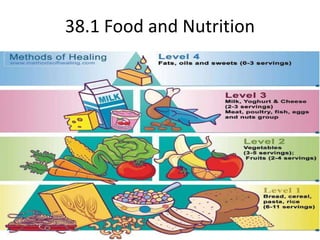Signaler
Partager

Contenu connexe
Tendances (18)
Similaire à Biology 38.1
Similaire à Biology 38.1 (20)
Physical education sports and nutrition class XII-UNIT 2 PPT

Physical education sports and nutrition class XII-UNIT 2 PPT
Plus de Tamara
Plus de Tamara (20)
Biology 38.1
- 1. 38.1 Food and Nutrition
- 2. Calorie Amount of energy needed to raise the temperature of 1 gram of water by 1 degree Celsius.
- 3. Carbohydrate Compound made up of carbon, hydrogen, and oxygen atoms; major source of energy for the human body.
- 4. Fat Lipid; made up of fatty acids and glycerol; protects body organs, insulates body, and stores energy in the body.
- 5. Protein Macromolecule that contains carbon, hydrogen, oxygen, and nitrogen; needed by the body for growth and repair and to make up enzymes.
- 6. Vitamin Organic molecule that helps regulate body processes.
- 7. Mineral Inorganic nutrient the body needs, usually in small amounts.
- 8. Key Concept The nutrients that the body needs are water, carbohydrates, fats, proteins, vitamins, and minerals.
- 9. Key Concept Every cell in the human body needs water because many of the body’s processes, including chemical reactions, take place in water.